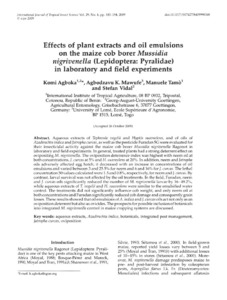| dc.contributor.author | Agboka, K. |
| dc.contributor.author | Mawufe, A.K. |
| dc.contributor.author | Tamo, M. |
| dc.contributor.author | Vidal, S. |
| dc.date.accessioned | 2019-12-04T11:14:39Z |
| dc.date.available | 2019-12-04T11:14:39Z |
| dc.date.issued | 2009 |
| dc.identifier.citation | Agboka, K., Mawufe, A.K., Tamo, M. & Vidal, S. (2009). Effects of plant extracts and oil emulsions on the maize cob borer Mussidia nigrivenella (Lepidoptera: pyralidae) in laboratory and field experiments. International Journal of Tropical Insect Science, 29(4), 185-194. |
| dc.identifier.issn | 1742-7584 |
| dc.identifier.uri | https://hdl.handle.net/20.500.12478/2823 |
| dc.description.abstract | Aqueous extracts of Tephrosia vogelii and Hyptis suaveolens, and of oils of Azadirachta indica and Jatropha curcas, as well as the pesticide Furadan 5G were evaluated for their insecticidal activity against the maize cob borer Mussidia nigrivenella Ragonot in laboratory and field experiments. In general, treated plants had a strong deterrent effect on ovipositing M. nigrivenella. The oviposition deterrence index was highest with neem oil at both concentrations, J. curcas at 5% and H. suaveolens at 20%. In addition, neem and Jatropha oils adversely affected egg hatch; it decreased with an increase in concentrations of oil emulsions and varied between 3 and 25.5% for neem and 6 and 16% for J. curcas. The lethal concentration 50 values calculated were 1.3 and 0.8%, respectively, for neem and J. curcas. By contrast, larval survival was not affected by the oil treatments. In the field, Furadan, neem and J. curcas oils significantly reduced the number of M. nigrivenella larvae by 16–49.2%, while aqueous extracts of T. vogelii and H. suaveolens were similar to the emulsified water control. The treatments did not significantly influence cob weight, and only neem oil at both concentrations and Furadan significantly reduced cob damage and consequently grain losses. These results showed that oil emulsions of A. indica and J. curcas oils act not only as an oviposition deterrent but also as ovicides. The prospects for possible inclusion of botanicals into integrated M. nigrivenella control in maize cropping systems are discussed. |
| dc.description.sponsorship | Directorate-General for International Cooperation, the Netherlands |
| dc.language.iso | en |
| dc.subject | Aqueous Extracts |
| dc.subject | Azadiraechta Indica |
| dc.subject | Botanicals |
| dc.subject | Integrated Pest Management |
| dc.subject | Jatropha Curcas |
| dc.subject | Oviposition |
| dc.title | Effects of plant extracts and oil emulsions on the maize cob borer Mussidia nigrivenella (Lepidoptera: pyralidae) in laboratory and field experiments |
| dc.type | Journal Article |
| dc.description.version | Peer Review |
| cg.contributor.affiliation | International Institute of Tropical Agriculture |
| cg.contributor.affiliation | Georg-August-Universität Göttingen |
| cg.contributor.affiliation | Université de Lomé |
| cg.coverage.region | Africa |
| cg.coverage.region | West Africa |
| cg.coverage.country | Benin |
| cg.isijournal | ISI Journal |
| cg.authorship.types | CGIAR and developing country institute |
| cg.iitasubject | Plant Diseases |
| cg.iitasubject | Pests Of Plants |
| cg.iitasubject | Disease Control |
| cg.iitasubject | Maize |
| cg.iitasubject | Plant Health |
| cg.iitasubject | Research Method |
| cg.iitasubject | Crop Systems |
| cg.accessibilitystatus | Limited Access |
| local.dspaceid | 93924 |
| cg.identifier.doi | http://dx.doi.org/10.1017/S1742758409990348 |

